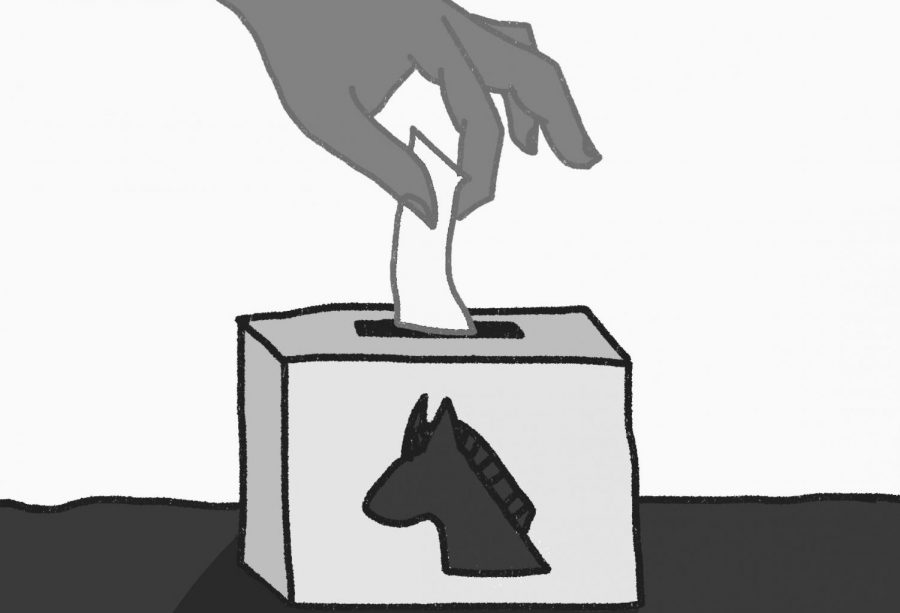Not all votes are equal
November 14, 2019
National polls can give you the wrong impression. Reading them, a casual observer may deduce that Democrats are primed to defeat Donald Trump in 2020. Our three front-runners — Joe Biden, Elizabeth Warren and Bernie Sanders — are each beating the incumbent in hypothetical matchups by more than seven percentage points, on average.
I’ve noticed that progressives use these polls to defend Warren and Bernie from charges of “unelectability.” Progressives cite these polls as validation that their candidates aren’t too far left for the American public, who are more ready for “big structural change” than the antics of the current president.
But it’s not whoever gets the most votes that’s elected president; it’s whoever wins the most electoral votes. Trump lost the popular vote by 3 million people in 2016, but he won over persuadable voters in six key battleground states that propelled him above 270 electoral votes.
By all accounts, the next election will again be decided by these six battleground states — Michigan, Wisconsin, Florida, North Carolina, Pennsylvania and Arizona — that each gave Trump his electoral win. And these states appear to be highly competitive this election season.
A third of battleground state voters say they will definitely vote for Trump, and a third say they will definitely vote for the Democrat. Another 20 percent are strongly leaning towards one party, but may end up not voting at all. That leaves about 15 percent of battleground voters that say there’s some chance of voting for either major party. We call these “persuadable voters.”
The New York Time’s polling guru Nate Cohn deftly explained the importance of this subset of voters: “Persuadable voters are so powerful because their votes can effectively count twice: A voter who flips from one party to the other not only adds a vote to one side, but also subtracts one from the other side’s tally. A wide array of evidence confirms their decisive role in recent elections.”
Any path towards 270 electoral votes relies on flipping three or so of these battleground states. Democrats could tack on a few more million votes to Hillary Clinton’s 66 and still lose if those aren’t in battleground states.
Three months away from the first vote of the primary (Ohio, on Feb. 3) and under a year away from the general election, polling suggests that a progressive candidate is not our best shot at persuading the voters we need to persuade. Recent NYT analysis has found persuadable battleground voters to be particularly disinterested in Warren’s “fight, fight, fight” mentality or Bernie’s ideological intransigence. By an overwhelming 80-10 percent margin, “these voters prefer a candidate who promises to find common ground over one who promises to fight for a Progressive agenda.” They aren’t particularly keen on the signature Progressive policies, either. They oppose Warren and Bernie’s single-payer Medicare for All system by a 60-37 percent margin, and oppose free college, 55-41.
If we’re going to defeat Trumpism and make its prophet only the sixth president to lose re-election, higher voting turnout of progressives and liberals will not be enough; we need the successful persuasion of centrist, battleground voters. This is the reality of the electoral college, and if we’re going to win the system, we need to start playing by the rules we were given — not the rules we wish we had.







Susan Anthony • Nov 15, 2019 at 7:56 am
The current presidential election system creates two kinds of Americans, those who matter and those who don’t. Those who are treated like they matter or they don’t matter. Those who believe that they matter or don’t matter.
Now we need to urge state legislators, in states with the 74 more electoral votes needed, to enact the National Popular Vote bill.
The bill is 73% of the way to guaranteeing the majority of Electoral College votes and the presidency to the candidate who receives the most popular votes in the country, by changing state winner-take-all laws (not mentioned in the U.S. Constitution, but later enacted by 48 states), without changing anything in the Constitution, using the built-in method that the Constitution provides for states to make changes.
It requires enacting states with 270 electoral votes to award their electoral votes to the winner of the most national popular votes.
All voters would be valued equally in presidential elections, no matter where they live.
Candidates, as in other elections, would allocate their time, money, polling, organizing, and ad buys roughly in proportion to the population
Every vote, everywhere, for every candidate, would be politically relevant and equal in every presidential election.
No more distorting, crude, and divisive red and blue state maps of predictable outcomes, that don’t represent any minority party voters within each state.
No more handful of ‘battleground’ states (where the two major political parties happen to have similar levels of support) where voters and policies are more important than those of the voters in 38+ predictable winner states that have just been ‘spectators’ and ignored after the conventions.
We can limit the outsized power and influence of a few battleground states in order to better serve our nation.